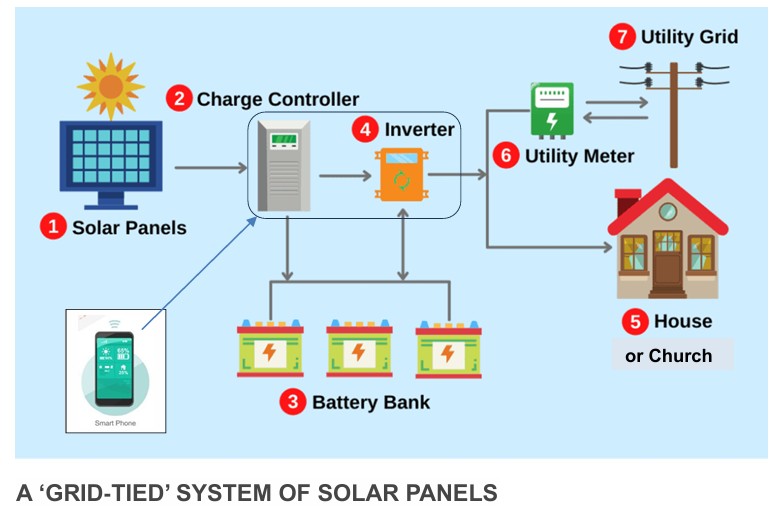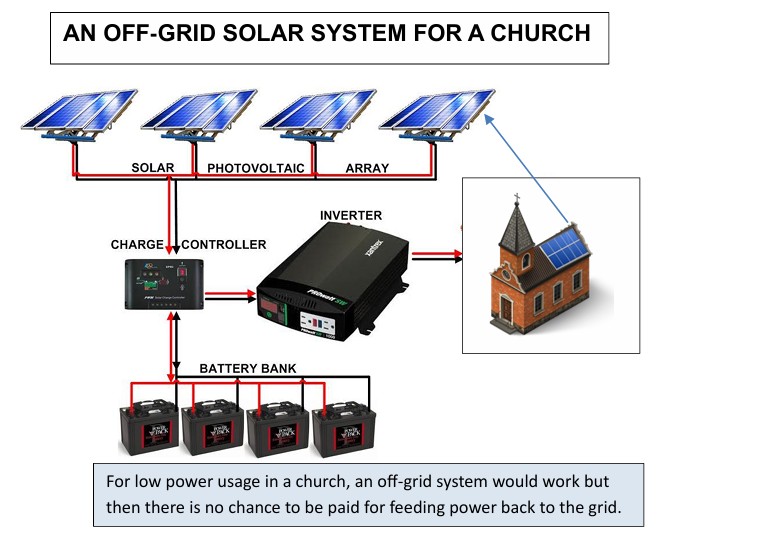RENEWABLE SOLAR ENERGY FOR CHURCHES
WHY?
Solar energy/radiation is what keeps us all alive
through sustaining plant life as well as driving the
atmospheric circulation. Fortunately, it is delivered to
the earth at a more or less steady 340 watts per
square metre. However, what we receive depends on
the rotation of the earth, the orientation of its axis as
well as adsorption by the atmosphere – hence the
seasonal and daily variation. Nevertheless, there is
plenty of radiation/energy there to be harvested, now
we have the technology!
Meanwhile, we as a community have chosen to generate the energy we need by
burning coal, oil or gas (‘fossil fuels’) which we can think of as the earth’s geological
battery, since they represent energy (carbon) stored in a bygone geological era. The
problem is that any such burning of fossil fuels (hydrocarbons) results in the
emissions of carbon dioxide (CO2) which, in turn, accumulates in the atmosphere.
This increasing concentration of CO2 acts as a trap for some of the delivered
incoming solar radiation – the so-called GreenHouse Gas (GHG) effect. The
consequence is increasing energy in the atmosphere at the earth’s surface,
increasing air temperature and energizing the circulating weather systems – and
changing the global climate.
Our mission is to try and mitigate these effects on climate by reducing our
dependence on fossil fuels, avoiding the consumption of energy from fossil fuel
power stations. Thus, the use of solar panels, directly harvesting solar energy has a
significant environmental benefit. A solar panel installation may also have an
economic benefit to the user!
Now that domestically harvested solar energy can be sold back to the national grid,
the problem is to optimize return, based on several factors: the demand for energy
from a building, charging any associated batteries and selling the surplus back to the
grid, while also talking account of the tariff structure (‘day rates’, ‘night rates’ and
‘grid feedback’ rates) of the energy supplier, all of which can change frequently.
There is a capital cost to installing solar panels and the so-called payback period
indicates how long it would take for the generated savings in supply charges to be
balanced by the original capital cost. The length of the payback period will depend
on the levels of these fluctuating rates! Moreover, the equipment for solar panel
installations is rapidly evolving both in costs and technology. Nevertheless, the
environmental benefits of a solar installation should encourage a best shot at design
in the prevailing circumstances – and churches present a particular circumstance!
A solar panel system comprises four components: an array of solar panels which
convert solar energy into DC electric current, one or more batteries (if required) to
provide storage, the demand from the building and an inverter which converts DC
current into AC, which the building and grid require. The inverter is also the brains of
the system with modern hybrid versions using the internet and AI to reconcile the
connection of energy sources with demand, to maximize economic return. Additional
factors in design include a constraint on the amount of power (energy) that can be
delivered to the grid by the inverter (currently a nominal 5Kw), the capacity and cost
of batteries, and the pattern of the building’s demand for power.
Churches present particular circumstances for solar system design. Rural churches
are often small consumers of power, sometimes confined to one day per week and
little more than lighting and some heating. The standing charge from the grid supplier
often competed with the charge for actual power consumption, although in recent
years, the rates have fluctuated between 18 and 45 cents per unit (KWh)! However,
churches have one advantage for solar panels since most churches are oriented
east-west, meaning that at least one aspect of the roof is likely to be facing south,
the best direction for solar energy harvesting.
Currently, there is no requirement to apply for planning permission for any number of
solar panels on houses or buildings such as churches and schools. There is a
nominal limit of 25 sq.m. for the area of solar panels on a ground mounted system
not requiring planning permission. However, there is one caveat for listed buildings
as enunciated recently by Malcolm Noonan, Minister of State with responsibility for
Heritage and Electoral Reform, “while buildings and areas of architectural heritage significance
have a role to play in meeting our renewable energy ambition, it is important that we ensure sufficient
safeguards for our protected structures and architectural conservation areas from inappropriate
development. I am satisfied that these amendments as well as the existing safeguards in the Planning
Act and Regulations provide the necessary safeguards. In most instances, a case-by-case
assessment by the relevant planning authority will be necessary to ensure that solar development
does not materially affect the character of our protected structures and Architectural Conservation
Areas. I’d encourage people to engage with their local Heritage Officer or Conservation Officer for
information and support.” In short, talk to the County Heritage Officer before undertaking
a planning application.
HOW?

A ‘GRID-TIED’ SYSTEM OF SOLAR PANELS
FACTORS TO BE CONSIDERED IN DESIGN
or Church
• Number of solar panels – multiply the nominal rating of one panel by its rating
(typically 0.4 – 0.6 kW), by the number of panels, so the total does not exceed
10Kw. They will not all operate at full power, depending on incoming solar
radiation and the total output should not exceed the capacity of the inverter to
cope with it (otherwise excess energy generated will be wasted). Typically,
this will result in a maximum number of 20-22 panels. This maximum is
probably much more than needed to supply the church but the excess will be
fed to the grid, generating a financial return.
• Type of panel – should be a ‘tier 1’ monocrystalline panel and robust, given
the windy weather conditions in the west of Ireland. Check the wind rating –
should exceed 90km/hr on a roof and 120km/hr on a ground system.
• Batteries – act as storage for solar generated power produced when the
building does not need it. They can also be charged from the grid during low
rate night hours and can then supply the building back during daytime hours
at no charge. Most battery systems operate best in warm conditions, hence
look to be located indoors but need air space around them to meet fire
regulations.
Some battery systems can be located outdoors but usually carry an internal
heating system to counteract cold periods (heating systems which demand
power in themselves). Current battery technology uses lithium-iron-phosphate
technology which is much safer than previous lithium ion technology but still
carries a very low fire risk – hence the regulation.
• How many batteries? For low power usage in a church, there is no need for
any, or at most, one. For periods of low solar energy output, as in winter,
residual building energy demand can be met from the grid. This is more than
compensated for by the surplus solar energy output in summer which can be
fed to the grid. There is always a trade-off between the additional power
provided by a battery against its cost (up to €3000) lengthening the payback
period. Batteries also have less of a lifespan than solar panels, typically 10
years, although they will probably last longer.
• Inverter. While nominally converting DC current from the panels and batteries
to AC (which the building and grid require), the unit usually incorporates a
smart system (known as a hybrid inverter) for routing power between the
panels, the batteries, the grid and the building depending on conditions. It is
also the controller for the limit of power that can be fed to the grid (a national
regulation). There are a variety of hybrid inverters included in solar system
packages as the technology advances – since the routing process is a
complex task. Be aware that many now require internet connection and use AI
to program in real time. On the other hand, the simpler ones can be
programmed manually, albeit interrogatable by smart phone.
• Smart meters. Installation of a solar panel system currently requires
connection to a smart meter in the ESB meter box. While it is national policy
to install smart meters in all buildings anyway, it is not mandatory to subscribe
to their operation – unless a solar system is installed. Although this
switchover is probably worthwhile, as it allows much better management of
power usage, there is an issue with timing of night rates for power usage. For
older meter ESB connections, the night rate runs from 11pm to 8am (9 hours
at the cheaper rate) whereas under the smart meter system, that reduces to 4
hours (2am-6am). Although the night rate is approximately half of the day rate
per kWh/unit, this change has implications for the way usage is economically
programmed. However, for a church, this change may not be significant.
• Usage. The current pattern of daily and seasonal power usage (kWh) in a
building is usually the basis for the design of a solar system. While the more
solar panels there are, the more power is generated when there is sufficient
incoming radiation/solar energy/sunshine, but the ability to use that power at
the time it is produced is governed by the building’s demand, the amount of
battery storage and the limit on the feed to the grid. While good design can
optimize the system and its financial benefit, ultimately it is the management
of demand that will help both environmentally as well as financially in running
costs. Go for LED light bulbs, increasing building insulation and A-rated
appliances!
• Off-grid systems. Most of the solar systems on offer are ‘grid-tied’ meaning
that the electricity grid remains connected to the building and the solar panel
system is integrated with it. However, for low power users, like rural
churches, a case can be made for going ‘off-grid’ – ie generating all the
building’s power requirements from the solar panel array. In this case, there is
no limit on the number of solar panels and batteries which are used to store
the solar energy in times of low solar energy generation. Care is needed in
analysing current power usage in the church in order to assess feasibility of
an off-grid system.
AN OFF-GRID SOLAR SYSTEM FOR A CHURCH
For low power usage in a church, an off-grid system would work but
then there is no chance to be paid for feeding power back to the grid.

WHEN?
Nearly all solar systems are bought as packages from professional installers, the
number of whom have mushroomed in the last 2 years, although, to avail of grants,
an installer has to be registered with the government Sustainable Energy agency,
SEAI. The available grants for installation are significant and typically amount to
some 25% of the costs of installation (which usually does not include any costs of
infrastructure such as cable trenching etc). As charity trustees, the Select Vestry of a
church should be able to avail of these grants, although the legal owner is the RCB.
It is worth seeking out an experienced installer, to discuss the various options, as
described, to optimize the environmental benefits as well as the financial return!
Paul Johnston. Cong & Aasleagh Parish Union.
